Wai-Fah Chen.The Civil Engineering Handbook
Подождите немного. Документ загружается.

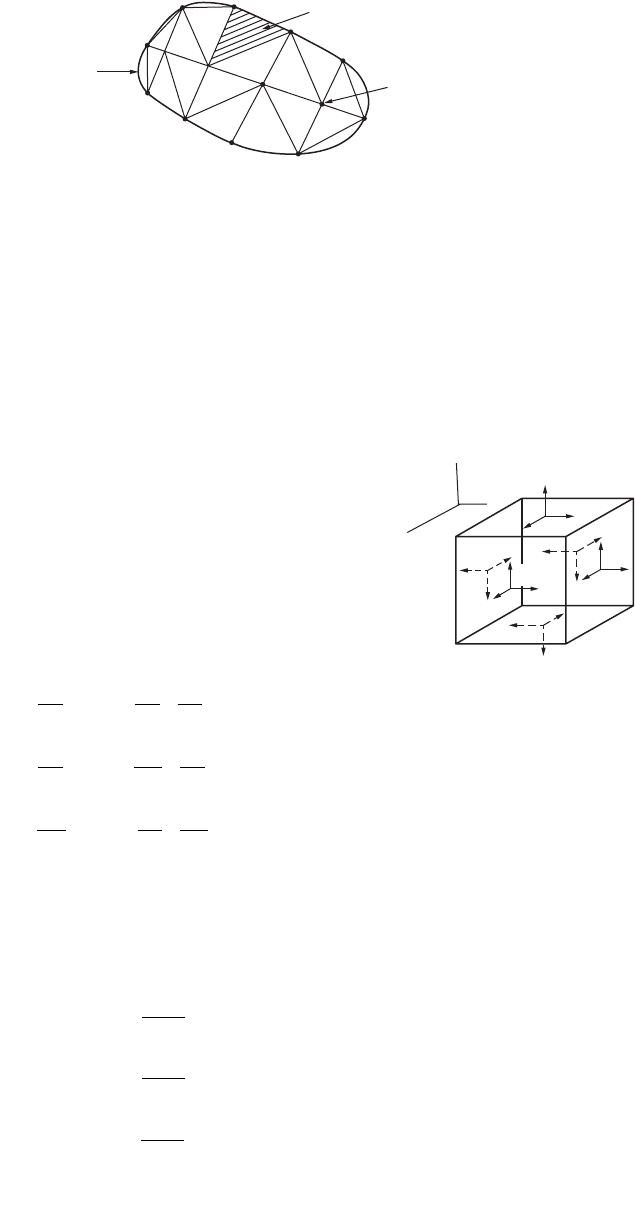
Theory and Analysis of Structures 47-91
The entire procedure of the finite element method involves the following steps:
1. The given body is subdivided into an equivalent system of finite elements.
2. A suitable displacement function is chosen.
3. The element stiffness matrix is derived using a variational principle of mechanics, such as the
principle of minimum potential energy.
4. The global stiffness matrix for the entire body is formulated.
5. The algebraic equations thus obtained are solved to determine unknown displacements.
6. The element strains and stresses are computed from the nodal displacements.
Elastic Formulation
Figure 47.83 shows the state of stress in an elemental volume of a
body under load. It is defined in terms of three normal stress com-
ponents s
x
, s
y
, and s
z
and three shear stress components t
xy
, t
yz
,
and t
zx
. The corresponding strain components are three normal
strains e
x
, e
y
, and e
z
and three shear strains g
xy
, g
yz
, and g
zx
. These
strain components are related to the displacement components u, v,
and w at a point as follows:
(47.149)
The relations given in Eq. (47.149) are valid in the case of the body experiencing small deformations. If
the body undergoes large or finite deformations, higher order terms must be retained.
The stress–strain equations for isotropic materials may be written in terms of Young’s modulus and
Poisson’s ratio as
(47.150)
FIGURE 47.82 Assemblage of subdivisions.
Boundary of
a region
Typical element
Typical node
FIGURE 47.83 State of stress in an
elemental volume.
x
z
y
0
τ
zy
σ
y
σ
z
τ
zx
τ
yx
τ
xz
τ
xy
τ
yz
τ
yz
τ
yx
σ
x
σ
y
P
x
xy
y
yz
z
zx
u
x
v
x
u
y
v
y
w
y
v
z
w
z
u
z
w
x
e
g
e
g
e
g
=
∂
∂
=
∂
∂
+
∂
∂
=
∂
∂
=
∂
∂
+
∂
∂
=
∂
∂
=
∂
∂
+
∂
∂
x
2
xyz
y
2
yzx
z
2
zxy
xy
xy
yz
yz
zx
zx
E
1
E
1
E
1
G, G , G
s
n
e
n
ee
s
n
e
n
ee
s
n
e
n
ee
t
g
t
g
t
g
=
-
++
()
[]
=
-
++
()
[]
=
-
++
()
[]
===
© 2003 by CRC Press LLC
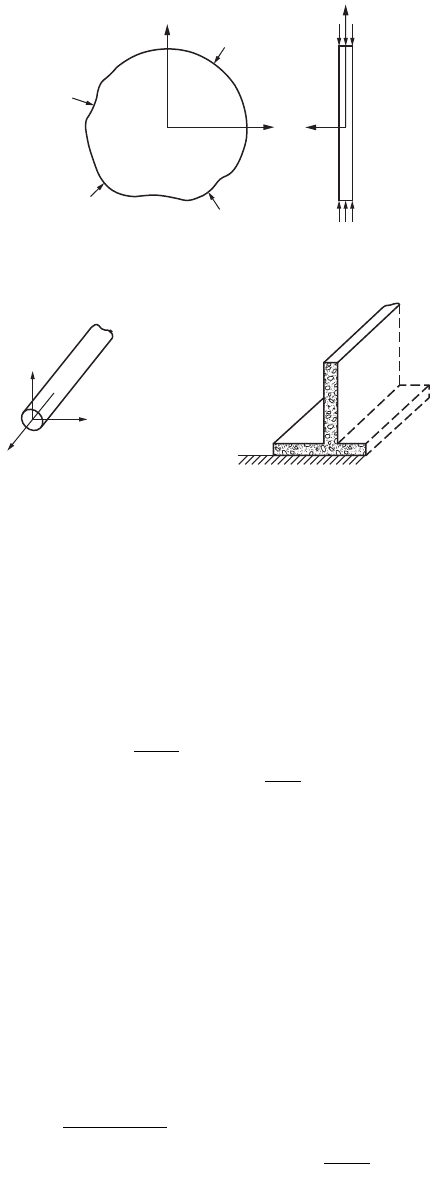
47-92 The Civil Engineering Handbook, Second Edition
Plane Stress
When the elastic body is very thin and there are no loads applied in the direction parallel to the thickness,
the state of stress in the body is said to be plane stress. A thin plate subjected to in-plane loading, as
shown in Fig. 47.84, is an example of a plane stress problem. In this case, s
z
= t
yz
= t
zx
= 0 and the
constitutive relation for an isotropic continuum is expressed as
(47.151)
Plane Strain
The state of plane strain occurs in members that are not free to expand in the direction perpendicular
to the plane of the applied loads. Examples of some plane strain problems are retaining walls, dams, long
cylinders, tunnels, etc., as shown in Fig. 47.85. In these problems e
z
, g
yz
, and g
zx
will vanish and hence
The constitutive relations for an isotropic material is written as
(47.152)
FIGURE 47.84 Plane stress problem.
FIGURE 47.85 Practical examples of plane strain problems.
y
x
z
y
x
y
z
s
s
s
n
n
n
n
e
e
g
x
y
xy
x
y
xy
E
È
Î
Í
Í
Í
˘
˚
˙
˙
˙
=
-
-
È
Î
Í
Í
Í
Í
˘
˚
˙
˙
˙
˙
È
Î
Í
Í
Í
˘
˚
˙
˙
˙
1
10
10
00
1
2
2
zxy
s
n
ss
=+
()
s
s
t
nn
nn
nn
n
e
e
g
x
y
xy
x
y
xy
E
È
Î
Í
Í
Í
˘
˚
˙
˙
˙
=
+
()
-
()
-
()
-
()
-
È
Î
Í
Í
Í
Í
Í
˘
˚
˙
˙
˙
˙
˙
È
Î
Í
Í
Í
˘
˚
˙
˙
˙
112
10
10
00
12
2
© 2003 by CRC Press LLC
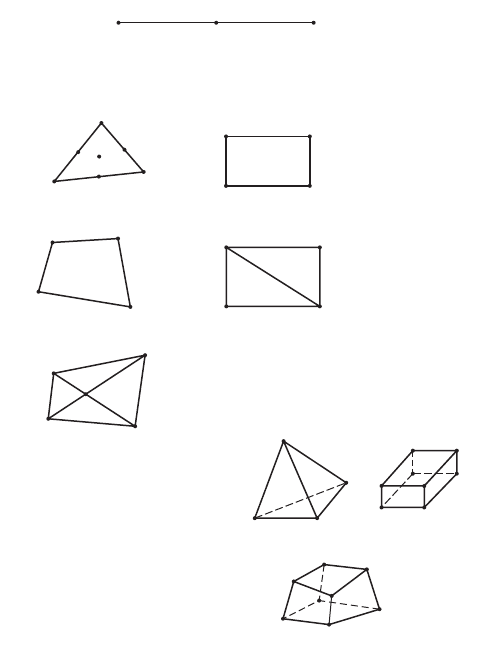
Theory and Analysis of Structures 47-93
Choice of Element Shapes and Sizes
A finite element generally has a simple one-, two-, or three-dimensional configuration. The boundaries
of elements are often straight lines, and the elements can be one-, two-, or three-dimensional, as shown
in Fig. 47.86. While subdividing the continuum, one has to decide the number, shape, size, and config-
uration of the elements in such a way that the original body is simulated as closely as possible. Nodes
must be located in locations where abrupt changes in geometry, loading, and material properties occur.
A node must be placed at the point of application of a concentrated load because all loads are converted
into equivalent nodal-point loads.
It is easy to subdivide a continuum into a completely regular one having the same shape and size. But
problems encountered in practice do not involve regular shape; they may have regions of steep gradients
of stresses. A finer subdivision may be necessary in regions where stress concentrations are expected in
order to obtain a useful approximate solution. Typical examples of mesh selection are shown in Fig. 47.87.
Choice of Displacement Function
Selection of displacement function is the important step in the finite element analysis, since it determines
the performance of the element in the analysis. Attention must be paid to select a displacement function
that:
FIGURE 47.86 (a) One-dimensional element. (b) Two-dimensional element. (c) Three-dimensional element.
NODE 1 NODE 2
NODE 3
(a) One-dimensional Element
1
2
3
4
5
6
7
1
2
3
4
1
2
3
4
1
2
3
4
5
(b) Two-dimensional Element
1
2
3
4
12
3
4
5
6
7
8
1
2
3
4
5
6
7
8
(c) Three-dimensional Element
© 2003 by CRC Press LLC
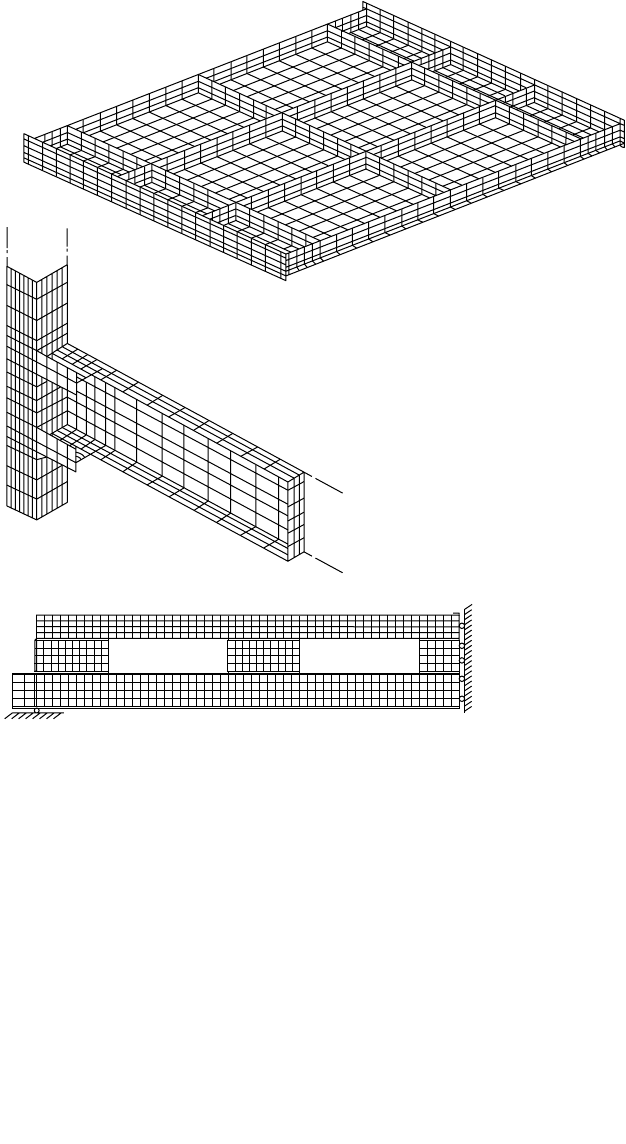
47-94 The Civil Engineering Handbook, Second Edition
1. has the number of unknown constants as the total number of degrees of freedom of the element.
2. does not have any preferred directions.
3. allows the element to undergo rigid-body movement without any internal strain.
4. is able to represent states of constant stress or strain.
5. satisfies the compatibility of displacements along the boundaries with adjacent elements.
Elements that meet both 3 and 4 are known as complete elements.
A polynomial is the most common form of displacement function. Mathematics of polynomials are
easy to handle in formulating the desired equations for various elements and convenient in digital
computation. The degree of approximation is governed by the stage at which the function is truncated.
Solutions closer to exact solutions can be obtained by including a greater number of terms. The poly-
nomials are of the general form
(47.153)
The coefficient a’s are known as generalized displacement amplitudes. The general polynomial form for
a two-dimensional problem can be given as
FIGURE 47.87 Typical examples of finite element mesh.
Q
Q
Q
Q
wx a a x a x a x
n
n
()
=+ + +º
+12 3
2
1
© 2003 by CRC Press LLC

Theory and Analysis of Structures 47-95
in which
(47.154)
These polynomials can be truncated at any desired degree to give constant, linear, quadratic, or higher
order functions. For example, a linear model in the case of a two-dimensional problem can be given as
(47.155)
A quadratic function is given by
(47.156)
Pascal’s triangle, shown below, can be used for the purpose of achieving isotropy, i.e., to avoid displace-
ment shapes that change with a change in the local coordinate system.
Nodal Degrees of Freedom
The deformation of the finite element is specified completely by the nodal displacement, rotations, and/or
strains, which are referred to as degrees of freedom. Convergence, geometric isotropy, and potential energy
function are the factors that determine the minimum number of degrees of freedom necessary for a given
element. Additional degrees of freedom beyond the minimum number may be included for any element
by adding secondary external nodes, and such elements with additional degrees of freedom are called
higher order elements. The elements with more additional degrees of freedom become more flexible.
Isoparametric Elements
The scope of finite element analysis is also measured by the variety of element geometries that can be
constructed. Formulation of element stiffness equations requires the selection of displacement expressions
with as many parameters as there are node point displacements. In practice, for planar conditions, only
the four-sided (quadrilateral) element finds as wide an application as the triangular element. The simplest
form of quadrilateral, the rectangle, has four node points and involves two displacement components at
each point, for a total of eight degrees of freedom. In this case one would choose four-term expressions
for both u and v displacement fields. If the description of the element is expanded to include nodes at
the midpoints of the sides, an eight-term expression would be chosen for each displacement component.
The triangle and rectangle can approximate the curved boundaries only as a series of straight line
segments. A closer approximation can be achieved by means of isoparametric coordinates. These are
nondimensionalized curvilinear coordinates whose description is given by the same coefficients as are
1Constant
xy Linear
x
2
xy y
2
Quadratic
x
3
x
2
yxy
2
y
3
Cubic
x
4
x
3
yx
2
y
2
xy
3
y
4
Quantic
x
5
x
4
yx
3
y
2
x
2
y
3
xy
4
y
5
Quintic
uxy a a x ay ax axy ay ay
vxy a a a y a x a xy a y a y
m
n
mm m m m m m
n
,
,
()
=+ + + + + +º
()
=++ + + + +º+
++ + + + +
12 3 4
2
56
2
123 4
2
56
2
2
mi
i=1
n+1
=
Â
ua axay
va axay
=+ +
=+ +
12 3
45 6
ua axayax axy ay
va axay a x a xy a y
=+ + + + +
= +++ + +
12 3 4
2
56
2
78 9 10
2
11 12
2
© 2003 by CRC Press LLC
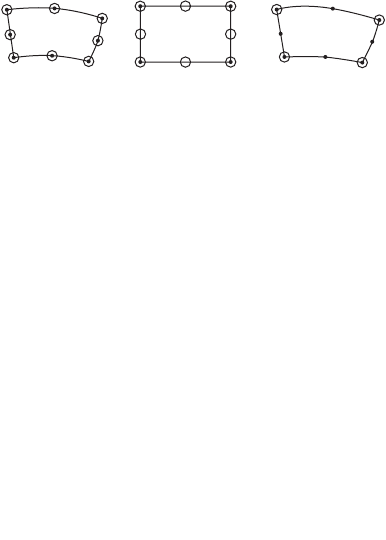
47-96 The Civil Engineering Handbook, Second Edition
employed in the displacement expressions. The displacement expressions are chosen to ensure continuity
across element interfaces and along supported boundaries, so that geometric continuity is ensured when
the same forms of expressions are used as the basis of description of the element boundaries. The elements
in which the geometry and displacements are described in terms of the same parameters and are of the
same order are called isoparametric elements. The isoparametric concept enables one to formulate ele-
ments of any order that satisfy the completeness and compatibility requirements and that have isotropic
displacement functions.
Isoparametric Families of Elements
Definitions and Justifications
For example, let u
i
represent nodal displacements and x
i
represent nodal x coordinates. The interpolation
formulas are
where N
i
and N are shape functions written in terms of the intrinsic coordinates. The value of u and the
value of x at a point within the element are obtained in terms of nodal values of u
i
and x
i
from the above
equations when the (intrinsic) coordinates of the internal point are given. Displacement components v
and w in the y and z directions are treated in a similar manner.
The element is isoparametric if m = n, N
i
= N, and the same nodal points are used to define both
element geometry and element displacement (Fig. 47.88a); the element is subparametric if m > n, the
order of N
i
is larger than N¢
i
(Fig. 47.88b); the element is superparametric if m < n, the order of N
i
is
smaller than N¢
i
(Fig. 47.88c). The isoparametric elements can correctly display rigid-body and constant-
strain modes.
Element Shape Functions
The finite element method is not restricted to the use of linear elements. Most finite element codes
commercially available allow the user to select between elements with linear or quadratic interpolation
functions. In the case of quadratic elements, fewer elements are needed to obtain the same degree of
accuracy in the nodal values. Also, the two-dimensional quadratic elements can be shaped to model a
curved boundary. Shape functions can be developed based on the following properties:
1. Each shape function has a value of 1 at its own node and is zero at each of the other nodes.
2. The shape functions for two-dimensional elements are zero along each side that the node does
not touch.
3. Each shape function is a polynomial of the same degree as the interpolation equation. Shape
functions for typical elements are given in Fig. 47.89a and b.
Formulation of Stiffness Matrix
It is possible to obtain all the strains and stresses within the element and to formulate the stiffness matrix
and a consistent load matrix once the displacement function has been determined. This consistent load
matrix represents the equivalent nodal forces that replace the action of external distributed loads.
FIGURE 47.88 (a) Isoparametric element. (b) Subparametric element. (c) Superparametric element.
(a) (b) (c)
u x
i=1
m
i=1
n
==
¢
ÂÂ
Nu N x
ii i i
© 2003 by CRC Press LLC
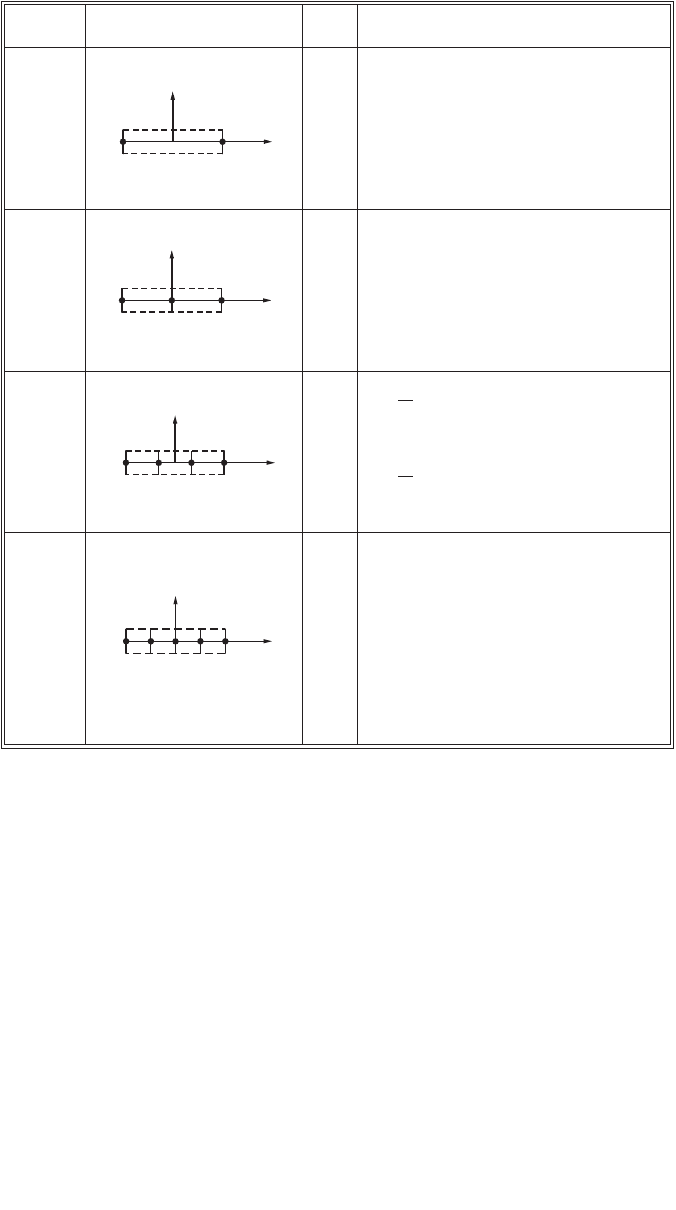
Theory and Analysis of Structures 47-97
As an example, let us consider a linearly elastic element of any of the types shown in Fig. 47.90. The
displacement function may be written in the form
(47.157)
in which {f} may have two components {u, v} or simply be equal to w, [P] is a function of x and y only,
and {A} is the vector of undetermined constants. If Eq. (47.157) is applied repeatedly to the nodes of the
element one after the other, we obtain a set of equations of the form
(47.158)
in which {D
*
} is the nodal parameters and [C] is the relevant nodal coordinates. The undetermined
constants {A} can be expressed in terms of the nodal parameters {D
*
} as
(47.159)
FIGURE 47.89 Shape functions for typical elements.
Five-node
quartic
element
Four-
node
cubic
element
Three-
node
parabolic
element
Two-node
linear
element
Element
name
Configuration DOF Shape functions
234
23
1
(−1,0)
1
(−1,0)
(−1,0)
5
(1,0)
4
(1,0)
(1,0)
ξ
η
ξ
η
123
ξ
η
(−1,0)
(1,0)
12
ξ
η
+
+
+
+
N
i
=
1
−
2
(1
+
ξ
0
);
i
=
1, 2
N
i
=
1
−
2
ξ
0
(1
+
ξ
0
); i
=
1, 3
N
i
=
(1
−
ξ
2
); i
=
2
N
i
=
1
1
6
(1
+
ξ
0
)(9ξ
2
−
1)
i
=
1, 4
N
i
=
1
9
6
(1
+
9ξ
0
)(1
−
ξ
2
)
i
=
2, 3
N
i
=
1
−
6
(1
+
ξ
0
) {4ξ
0
(1
−
ξ
2
)
+
3ξ
0
}
i
=
1, 5
N
i
=
4ξ
0
(1
−
ξ
2
)(1
+
4ξ
0
)
i
=
2, 4
N
3
=
(1
−
4ξ
2
)(1
−
ξ
2
)
fPA
{}
=
[]
{}
DCA*
{}
=
[]
{}
ACD
{}
=
[]
{}
-1
*
© 2003 by CRC Press LLC
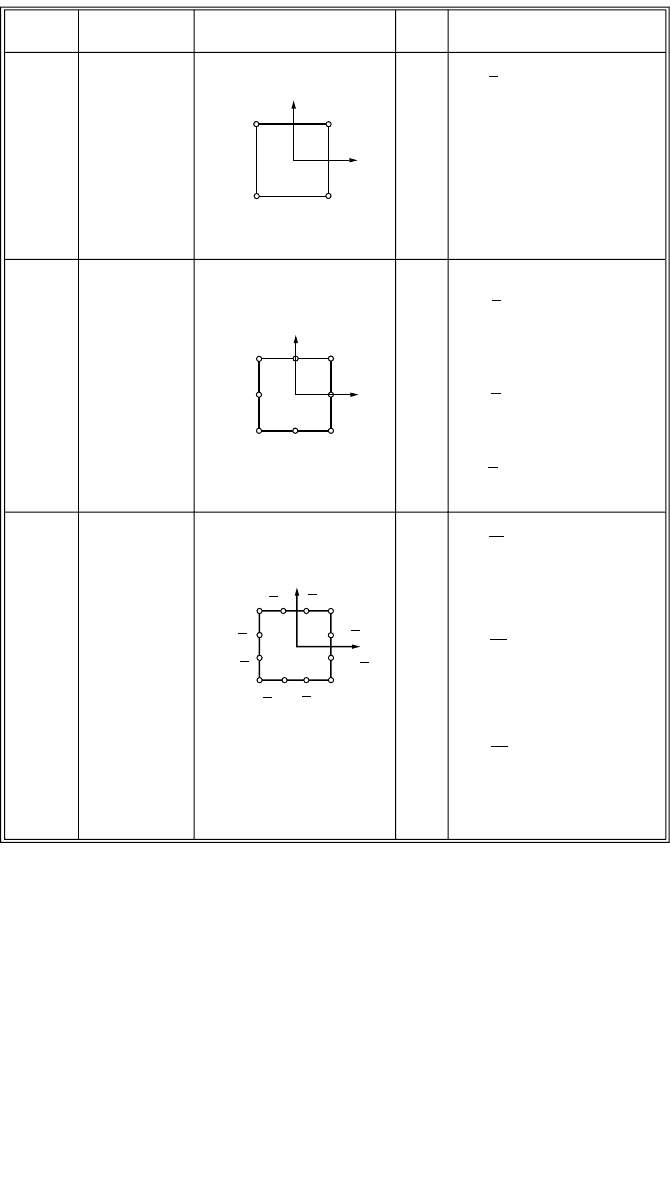
47-98 The Civil Engineering Handbook, Second Edition
Substituting Eq. (47.159) into (47.157)
(47.160)
Constructing the displacement function directly in terms of the nodal parameters, one obtains
(47.161)
where [L] is a function of both (x, y) and (x, y)
i,j,m
given by
(47.162)
FIGURE 47.89 (continued).
Element
name
Configuration
η
η
η
ξ
ξ
ξ
(1,1)
(1,1)
(1,0)
(0,1)
(1,−1)
(1,−1)
(−1,1)
(−1,1)
(−1,0)
(−1,−1)
(−1,−1)
(0,−1)
4
1
1
2
2
3
4
6
7
5
8
3
1
23
4
5
6
7
8
10
9
11
12
(−
1
3
,1)
(
1
3
,1
)
(1,
1
3
)
(−1,
1
3
)
(
−1,−
1
3
)
(
1
3
,−1
)
(
−
1
3
,−1)
(
1,−
1
3
)
(1,1)
(1,−1)
(−1,−1)
(−1,1)
Four-node
plane
quadrilateral
Eight-node
plane
quadrilateral
Twelve-node
plane
quadrilateral
DOF
u, v
u, v
u, v
Shape functions
N
i
=
1
4
(1 + ξ
0
)(1 + η
0
);
N
i
=
1
4
(1 + ξ
0
)(1 + η
0
)
N
i
=
3
1
2
(1 + ξ
0
)(1 + η
0
)
N
i
=
3
9
2
(1 + ξ
0
)(1 + η
2
)
N
i
=
3
9
2
(1 + η
0
)(1 − ξ
2
)
N
i
=
1
2
(1 − ξ
2
)(1 + η
0
)
N
i
=
1
2
(1 − η
2
)(1 + ξ
0
)
i = 1, 2, 3, 4
i = 1, 3, 5, 7
i = 2,6
i = 4, 8
i = 1, 4, 7, 10
(ξ
0
+ η
0
− 1);
(−10 + 9(ξ
2
+ η
2
))
(1 + 9η
0
)
i = 5, 6, 11, 12
(1 + 9ξ
0
)
i = 2, 3, 8, 9
Serial
no.
1
2
3
fPCD
{}
=
[][]
{}
-1
*
fLD
{}
=
[]
{}
*
LPC
[]
=
[][]
-1
© 2003 by CRC Press LLC
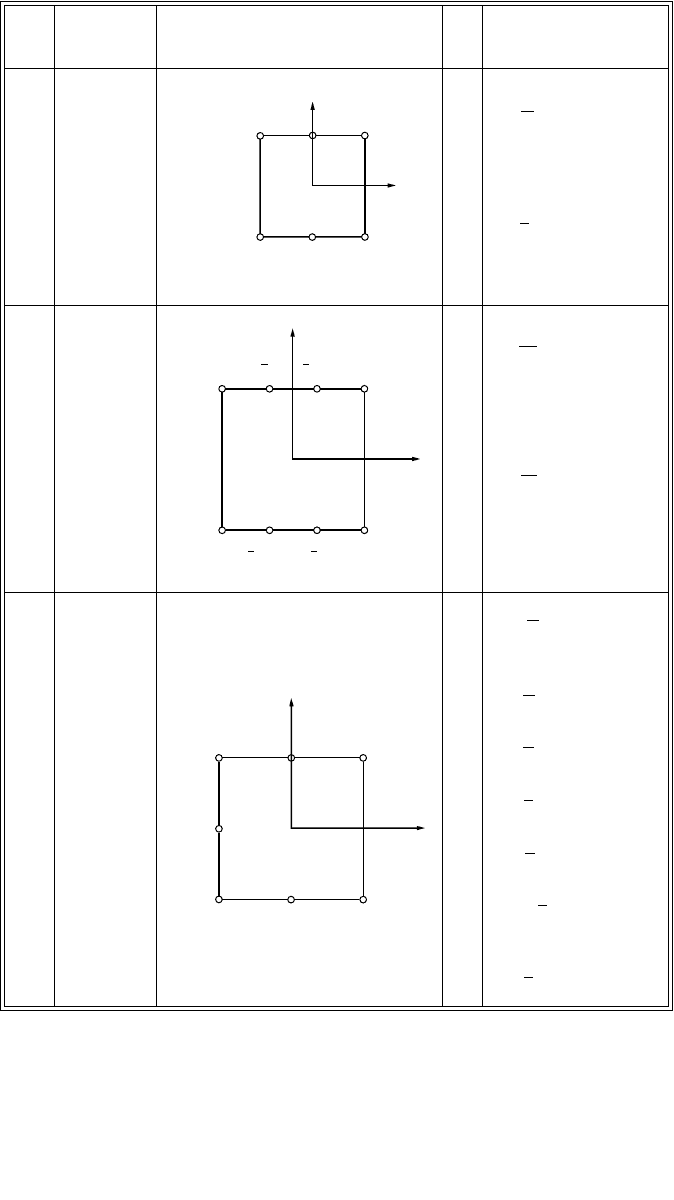
Theory and Analysis of Structures 47-99
The various components of strain can be obtained by appropriate differentiation of the displacement
function. Thus,
(47.163)
FIGURE 47.89 (continued).
(1,−1)
(1,−1)
(−1,1)
(−1,1)
(−1,−1)
(−1,−1) (1,−1)
(0,−1)
12
87
6
5
3
4
η
η
ξ
ξ
(0,1)
(1,1)
1
23
4
5
6
(−1,1)
(−1,0)
(−1,−1)
(1,−1)
(0,1)
(0,−1)
η
ξ
(1,1)
2
1
7
5
4
3
6
Serial
no.
Element
name
Configuration DOF Shape functions
4
Six-node
linear
quadrilateral
5
Eight-node
plane
quadrilateral
6
Seven-node
plane
quadrilateral
u, v
u, v
u, v
i = 1, 3, 4, 6
i = 2, 5
N
i
=
ξ
4
0
(1 + ξ
0
)(1 + η
0
)
N
i
=
1
2
(1 − ξ
2
)(1 + η
0
)
(1+η
0
)
(1+ η
0
)
i = 1, 4, 5, 8
i = 2, 3, 6, 7
N
i
=
3
9
2
(1 − ξ
2
)(1+9ξ
0
)
N
i
=
3
1
2
(1 + ξ
0
)( −1 + 9ξ
2
)
(1+ξ +η)
(1 + ξ − η)
N
5
=
1
2
(1 + η)(1 − ξ
2
)
N
6
= −
1
4
(1 − ξ)(1 + η)
N
7
=
1
2
(1 − ξ)(1 − η
2
)
N
3
=
ξ
4
(1 + ξ)(1 − η)
N
2
=
1
2
(1 − η)(1 − ξ
2
)
N
1
=
1
4
(1−ξ)(1 − η)
N
4
=
ξ
4
(1 + ξ)(1 + η)
(−
1
3
,1)
(−
1
3
,−1) (
1
3
,−1)
(
1
3
,1)
e
{}
=
[]
{}
BD*
© 2003 by CRC Press LLC

47-100 The Civil Engineering Handbook, Second Edition
[B] is derived by differentiating appropriately the elements of [L] with respect to x and y. The stresses {s}
in a linearly elastic element are given by the product of the strain and a symmetrical elasticity matrix [E].
Thus,
or
(47.164)
The stiffness and the consistent load matrices of an element can be obtained using the principle of
minimum total potential energy. The potential energy of the external load in the deformed configuration
of the element is written as
(47.165)
In Eq. (47.165) {Q
*
} represents concentrated loads at nodes, and {q} the distributed loads per unit
area. Substituting for {f}
T
from Eq. (47.161), one obtains
(47.166)
Note that the integral is taken over the area a of the element. The strain energy of the element integrated
over the entire volume v, is given as
Substituting for {e} and {s} from Eqs. (47.163) and (47.164), respectively,
(47.167)
FIGURE 47.90 Degrees of freedom: (a) triangular plane stress element, (b) triangular bending element.
w
m
i
j
x
z
y
i
j
z
y
m
(a)
6 degrees
of freedom
(b)
θ
y
se
{}
=
[]
{}
E
s
{}
=
[][]
{}
EBD*
WDQ fqda
TT
a
=-
{}{}
-
{} {}
Ú
**
WDQ D Lqda
TTT
a
=-
{}{}
-
{}
[]
{}
Ú
** *
Udv
T
v
=
{} {}
Ú
1
2
es
UD BEBdvD
TT
v
=
{}
[][][]
Ê
Ë
Á
Á
ˆ
¯
˜
˜
{}
Ú
1
2
**
© 2003 by CRC Press LLC
